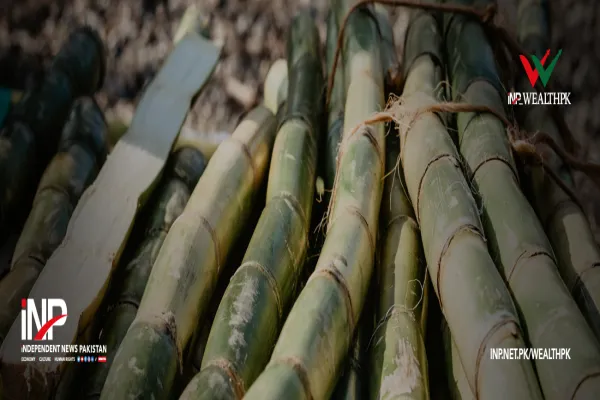i INP-WEALTHPK
Azeem Ahmed Khan
Pakistan’s banking sector disbursed agricultural loans worth Rs2.58 trillion during fiscal year 2024-25, slightly surpassing its annual target as the State Bank of Pakistan (SBP) rolled out new initiatives to expand credit access for small farmers and improve financial inclusion across the rural economy.
According to a document prepared by the SBP’s Agriculture Credit and Financial Inclusion Department, the Rs2.58 trillion disbursement equals 100.2 percent of the annual plan, showing sustained growth in agriculture financing nationwide. The total agri-lending was 16.3 percent higher than the Rs2.22 trillion extended during FY24.
The SBP said it had been working closely with banks and other stakeholders under its Agriculture Credit Expansion Plans (A-CEPs) to strengthen the flow of finance to the farming sector. Currently, 47 formal financial institutions provide agricultural loans, including five large commercial banks, 13 medium and small-sized commercial banks, six Islamic banks, two specialized banks, and 11 microfinance banks, besides 10 microfinance institutions and rural support programs.
The outstanding portfolio of agricultural loans rose by 13.8 percent to Rs995.3 billion at end-June 2025, up from Rs875 billion a year earlier. The number of active borrowers also grew 7.3 percent year-on-year to 2.9 million, reflecting deeper financial outreach in rural areas.
Punjab continued to dominate agricultural credit flows, receiving Rs2,045.1 billion or 103.6 percent of its A-CEP+ target. Sindh followed with Rs453.4 billion (93.1 percent achievement), while Khyber Pakhtunkhwa received Rs55.2 billion (68.9 percent). The remaining provinces and regions — Balochistan, Azad Jammu and Kashmir, and Gilgit-Baltistan — collectively secured Rs23.6 billion in credit.
Among financial institutions, five major commercial banks led the performance by disbursing Rs1,442.3 billion — 108 percent of their annual target. Specialized banks, including Zarai Taraqiati Bank Ltd and Punjab Provincial Cooperative Bank Ltd, together lent Rs85.6 billion, achieving 81 percent and 119 percent of their respective targets. Microfinance banks and microfinance institutions also performed strongly, disbursing Rs252.3 billion and Rs30 billion respectively, meeting 102.9 percent and 95.3 percent of their goals.
The farm and crop sector accounted for Rs1,443.8 billion, or 56 percent of total disbursements, marking a 19.3 percent increase over the previous year. The non-farm segment, which includes livestock, poultry, and agri-services, received Rs1,113.4 billion — 44 percent of total credit — reflecting a 12.8 percent rise year-on-year.
To promote agricultural financing, the SBP, in coordination with federal and provincial governments, launched several targeted schemes. The Risk Coverage Scheme for Small Farmers and Underserved Areas provides first-loss coverage of up to 10 percent to banks extending credit to small farmers in all provinces. It also offers a Rs10,000 subsidy per borrower to offset banks’ onboarding costs and will remain effective until FY28.
The scheme is expected to generate Rs100 billion in new loans annually and bring 250,000 new farmers into the formal credit system each year — totalling Rs300 billion in financing and 750,000 borrowers over its duration. The National Subsistence Farmers Support Initiative, another SBP-led project, introduces digital, collateral-free financing for smallholders through integrated bank portals, aiming to expand inclusion for landless and subsistence farmers.
Meanwhile, the Prime Minister’s Youth Business and Agriculture Loan Scheme (PMYB&ALS) achieved 100 percent of its targets in its first two phases. By June 2025, banks had disbursed Rs32 billion through 20 partner institutions, while the FY26 allocation has been raised to Rs65 billion.
The Electronic Warehouse Receipt Financing (EWRF) system, launched in 2022, continues to gain traction. It allows farmers, traders, and processors to obtain loans against stored commodities in accredited warehouses without conventional collateral. During FY25, banks provided Rs1.996 billion to 518 borrowers under EWRF. Since its inception, the scheme has enabled financing exceeding Rs10 billion.
The SBP, in collaboration with the National Institute of Banking and Finance, also organized three training programs for over 120 bank officials in Lahore, Karachi, and Islamabad. Efforts are also underway to digitize land records for collateralization of farm loans nationwide. In Punjab, 30 banks are now integrated with the Punjab Land Records Authority’s Land Record Management Information System.
Satellite-based land mapping is being adopted to verify ownership and improve the reliability of agri-loan processing. The SBP has also strengthened its Crop Loan Insurance Scheme and Livestock Insurance Scheme to protect borrowers from natural disasters such as floods, droughts, hailstorms, and livestock diseases. Between July 2008 and December 2024, banks processed Rs11.93 billion in insurance claims under these schemes, benefitting more than 7.13 million farmers across Pakistan.

Credit: INP-WealthPk









